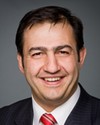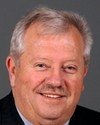I have about a minute left. I'll give everybody one minute for any last-minute questions.
Mr. Pacetti.
Evidence of meeting #26 for Transport, Infrastructure and Communities in the 40th Parliament, 2nd Session. (The original version is on Parliament’s site, as are the minutes.) The winning word was airports.
A recording is available from Parliament.
5:10 p.m.
Conservative

The Chair Conservative Merv Tweed
I have about a minute left. I'll give everybody one minute for any last-minute questions.
Mr. Pacetti.
5:10 p.m.
Liberal

Massimo Pacetti Liberal Saint-Léonard—Saint-Michel, QC
Just quickly, you cited vaguely, but I'm wondering if you have specific examples in Canada where you would see the public transit linking right away with the high-speed rail.
We always talk about the Quebec-Windsor corridor. It's something that every government has announced, provincially and federally. How is that going to impact the public transit?
At this point I think it's mutually exclusive, but you seem to think they still need to be worked on collectively. I think at this point we just have to invest in the high-speed rail. The public transit is another issue. I think it's mutually exclusive, but in the end, yes, they'll have to work together. But I think we have to get going on this high-speed rail. Is that correct or not?
5:10 p.m.
President and Chief Executive Officer, Canadian Urban Transit Association
We used to have a joke in our industry that said if you keep pushing the CTrain north and you keep pushing Edmonton's light rail further south, eventually they'll meet in Red Deer.
That's a joke.
5:10 p.m.
An hon. member
It's true.
5:10 p.m.
Conservative

Brian Jean Conservative Fort McMurray—Athabasca, AB
We don't even have a train in Fort McMurray, so why start it now?
5:10 p.m.
President and Chief Executive Officer, Canadian Urban Transit Association
You can say the same about the GO train going east from Toronto and the AMT going west from Montreal.
But all kidding aside, ultimately Union Station in Toronto and Gare Centrale in Montreal would be clear hubs for high-speed rail, for subways, for commuter rail, for everything linking those two regions. The others, whether it's Ottawa, Windsor, Quebec City, Edmonton, or Calgary, are far less clear because there really isn't a transportation hub.
5:10 p.m.
Liberal

Massimo Pacetti Liberal Saint-Léonard—Saint-Michel, QC
So the priority for you would be Montreal-Toronto?
5:10 p.m.
President and Chief Executive Officer, Canadian Urban Transit Association
Well, I think those are the two cities that have the most significant transportation hubs already in place.
5:10 p.m.
Bloc

Roger Gaudet Bloc Montcalm, QC
Thank you, Mr. Chair.
I have a very simple question. I have heard that you had a meeting that dealt with the specific needs of the AMT. Earlier, we talked about Toronto. What are the AMTs needs with regard to urban, public transit in Montreal?
5:10 p.m.
President and Chief Executive Officer, Canadian Urban Transit Association
My understanding is that the AMT must have the means to establish a truly integrated public transit network that meets the needs of Montrealers and residents of the greater Montreal area. That means that the public transit network on the island of Montreal, whether bus or metro, will become integrated with that of Laval, Longueuil and the north and south shores.
The CITs (intermunicipal transportation boards), which currently manage the suburban train service, have to be able to harmonize their rates and schedules. For instance, bus and train transportation have to connect in a timely manner. There has to be a network that meets the needs of the public, instead of 12 distinct networks. It is the AMT's role to ensure such intermunicipal integration. What are needed are financial means and the mechanism to conduct such planning.
5:15 p.m.
Bloc

Roger Gaudet Bloc Montcalm, QC
If I understand you correctly, if the network were to be completed — a study on a high speed rail system has already been launched by Montreal and Toronto — that would be a plus for high speed rail, because the two networks would intersect.
5:15 p.m.
President and Chief Executive Officer, Canadian Urban Transit Association
For a high speed train to be effective and financially viable, there cannot be too many stops. With speeds reaching 200, 300 or 400 kilometres an hour, such a train cannot stop at every station. Stops can only be located in areas with significant demand. There would likely be one stop and station per city.
5:15 p.m.
Bloc

Roger Gaudet Bloc Montcalm, QC
Very well.
In your view, what population size would justify a high speed rail station? Is it 100,000, 200,000 or 300,000 inhabitants?
June 16th, 2009 / 5:15 p.m.
President and Chief Executive Officer, Canadian Urban Transit Association
That is not really my area of expertise, but if you consider how things are elsewhere — in France, Germany or Spain, for example — there rarely are stops where fewer than 200,000 or 300,000 inhabitants can effectively access a station.
5:15 p.m.
Conservative
5:15 p.m.
Conservative

Jeff Watson Conservative Essex, ON
Thank you, Mr. Chair.
You've said here today that the consideration of high-speed rail and public transit ought to go hand in hand, essentially. We have heard cost estimates, by one of our witnesses, for a long-term commitment to high-speed rail of anywhere from $20 billion up to $50 billion. How much of an investment in the necessary connectivity in public transit would we be looking at by way of a commitment at one time?
5:15 p.m.
President and Chief Executive Officer, Canadian Urban Transit Association
I would take the question back to what is needed to provide the level of access and mobility needed by Canadians who are living in urban areas that are over 10,000 in population. Our estimate of that is approximately $40 billion over a five-year period. If you annualize that, you are looking at about $8 billion per year in expansion to keep up with growth and to replace the existing assets as they wear out.
That's about $8 billion per year shared, obviously, across the different jurisdictions in question.
5:15 p.m.
Conservative

The Chair Conservative Merv Tweed
Thank you very much for attending today and providing us with more information.
We're going to take a one-minute break. I'm going to ask that the room be cleared, as we're going in camera to discuss a bit of committee business. Then we'll wrap it up.
[Proceedings continue in camera]